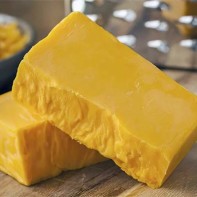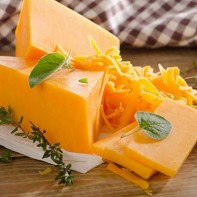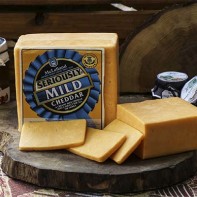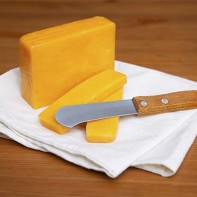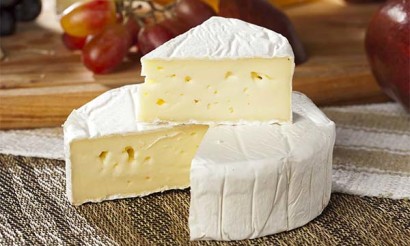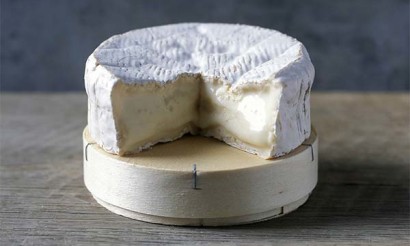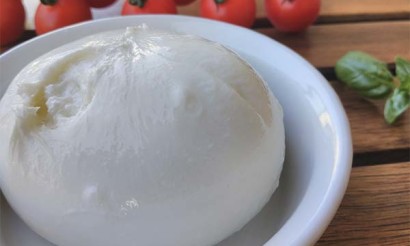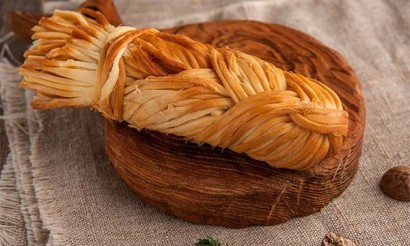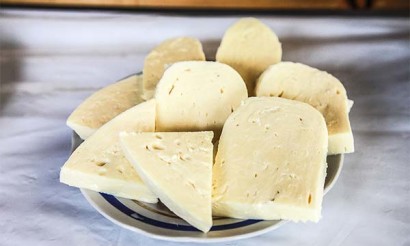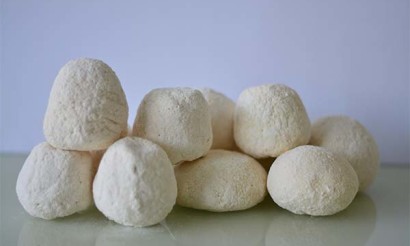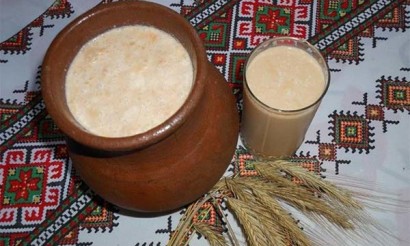Cheddar Cheese: composition, calories, useful properties and recipes
English cheese today is produced not only in the UK, but also in many countries around the world, including Russia, Australia, Canada and the United States. Cheddar spread around the world thanks to dairyman Joseph Harding, who promoted overseas hygiene, modernization of technology and standardization of the fermented product.
- Cheddar cheese: what it is, what it's made of, and what it tastes like
- History of Origin
- What is it made of?
- What does it taste like?
- Fat content
- Melt or not
- Types of
- Production Technology
- Different from Parmesan
- Composition and calories
- What is cheddar cheese good for?
- Hazards and contraindications
- How to choose and store
- Where to Buy and What it Costs
- How and with what to eat cheddar
- What Does It Go With?
- What Wine to match the Cheese
- How to Make Cheddar Cheese at Home
- What to make with cheddar: Recipes
- Pizza
- Salad
- Pasta
- Cheese Sauce
- Cheese Soup
- What can be substituted in recipes
- Interesting Facts
Cheddar Cheese: what it is, what it's made of, and what it tastes like
Cheddar is a type of hard cheese with a dense or crumbly structure, the absence of voids. Color - from creamy to orange, depending on age, food colorings. A product ubiquitous in cheese plates, not only tasty but also healthy.

History of Origin
Cheddar is made by local farmers of the village of the same name in Somerset. It is here that the caves are located, creating optimal conditions for maturation of cheese. The product has been known since the XII century. This fact is confirmed by the records on the parchment of Henry II, in which the king mentions the purchase of the product.
With the outbreak of World War II in England, cheddar moved into the category of products of paramount importance, became part of the war economy to the detriment of the production of other types of cheese. It was included in every soldier's diet.
According to studies by the United States Department of Agriculture, cheddar is the most researched and purchased cheese in the world.
What it's made from
The sour-milk product is made in large heads from pasteurized normalized cow's milk with the addition of calcium chloride, bacterial sourdough, and salt.
The more the cheese matures, the richer its flavor becomes.
How it tastes
When tasting the cheese, you can feel the sharp, creamy taste with a slight acidity, nutty notes in the aftertaste.
Fat content of cheese
Mass fraction of fat in the dry matter of cheddar is 50%. There are 30.8 g of saturated and unsaturated fatty acids in 100 gr.
Important! Cheese belongs to the caloric fatty varieties, for dietary nutrition is not suitable.
Melted or not.
Cheddar with high protein content melts well and stretches. This property is used in cooking, pizza, fondue, casseroles.
The soft consistency of the melted product is obtained by cooking over medium or low heat. Cooking cheddar on high heat makes the fibers of the cheese hard.
Tip! If you plan to melt, choose a young product. It contains more moisture.
Types
The type of cheddar depends on age:
- Young is a 3-month-old, pliable cheese with a dense body and a subtle sharpness.
- Medium-ripened cheddar with a spicy flavor and slight crumbliness matures for 6 months.
- Mature hard cheese with rich flavor, calcium crystals matures for 9 months.
- The product becomes vintage after a year and a half.
Over time, the cheddar loses moisture, and the structure thickens. The taste becomes brighter and richer, and the aftertaste lingers longer. While young and medium-ripeness cheddar heads may be cut with a knife, mature and vintage cheddars are split before being cut into bars.
Production technology
The long, labor-intensive process of making cheddar requires special equipment. When it is used, cheesemakers end up with 19-kg bars of creamy yellow color of hard consistency.
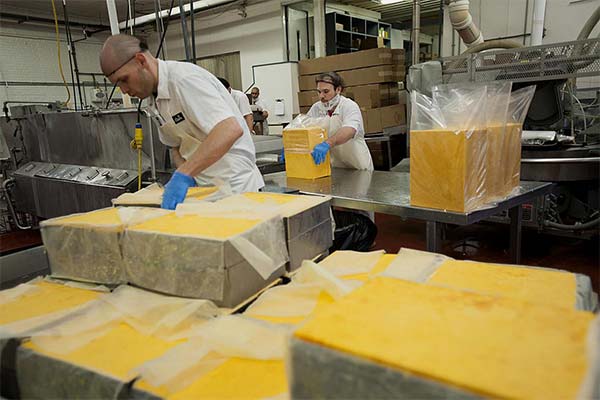
The production of the lactic acid product begins with pasteurization, normalization and heating of the milk to a temperature of 30-35 degrees.
A solution of calcium chloride and bacterial starter are added to the warm raw milk. After half an hour, the milk is fermented and a clot is formed. It is cut, drained to 40% of the whey. The cheese grains are kneaded for half an hour.
The curd is heated once more to 40 degrees. The curd is mechanically worked on the grains to make them more elastic. The cheese mass is sent to the moulding machine, where in 20 minutes a 30 cm layer of cheese is formed under the whey. The liquid is drained off, the product is cut into equal slices and sent for cheddarization.
The procedure consists of pressing the bars stacked on top of each other, with a gradually increasing number of rows. This technological operation accelerates the lactic fermentation and forms the desired structure of the cheddar.
The cheddarized cheese mass is cut into bars with sides of 2 and 4 cm. They are salted with dry salt or in brine to form rectangles weighing 19 kg. Then the cheese is pressed under pressure for 13 hours, wrapped in plastic film, and sent to a special storage facility to mature for at least 3 months.
How it differs from Parmesan
English cheddar differs from Italian Parmesan shorter maturation time, consistency, composition, and purpose.
Hard Parmesan, which is hard to cut with a knife, contains more protein, macronutrients and less saturated fat. Cheddar is the leader in the amount of micronutrients, vitamins A, D, PP, group B.
Parmesan is designed to enrich dishes with a bright flavor. It is added to pastries, pasta, risotto, salads after grating.
Cheddar is a table, versatile product. It is served on a cheese plate, as an appetizer for wine, beer and introduced in culinary recipes for complex dishes.
Composition and calories
Cheddar is rich in essential and essential amino acids, cobalamin, vitamins A, PP, and riboflavin. The cheese contains significant amounts of unsaturated fatty acids Omega-3, 6, calcium, phosphorus, selenium zinc.
Contents in 100 g of cheddar vitamins, minerals:
Vitamins:
- Cobalamin - 0.001 mg.
- A - 0.3 mg.
- PP - 6.1 mg.
- Riboflavin - 0.4 mg.
- Calciferol - 0.001 mg.
- Pyridoxine - 0.15 mg.
- Pantothenic acid - 0.3 mg.
- Tocopherol - 06 mg.
- Folate - 0.02 mg.
- Biotin - 0.002 mg.
- Thiamine - 0.05 mg.
- Beta carotene - 0.02 mg.
- K - 0.002 mg.
Trace elements:
- Selenium - 0.03 mg.
- Zinc - 4,5 mg.
- Copper - 0.09 mg.
- Iron - 1 mg.
- Manganese - 0.1 mg.
Macronutrients:
- Calcium - 1000 mg.
- Phosphorus - 545 mg.
- Sodium - 850 mg.
- Chlorine - 1310 mg.
- Sulfur - 235 mg.
- Magnesium - 54 mg.
- Potassium - 116 mg.
GI of 100 g of the product - 23,5 30,8, 3,4 g, respectively. Energy value - 380 kcal.
How is cheddar cheese useful?
Hard cheeses are called a calcium pantry not without reason. The mineral content of 100 grams of cheddar covers 100% of the daily requirement for the macronutrient. The high-quality protein in the product, which is assimilated better than in milk, is the building material of cells. It determines the metabolic processes, the immune system.
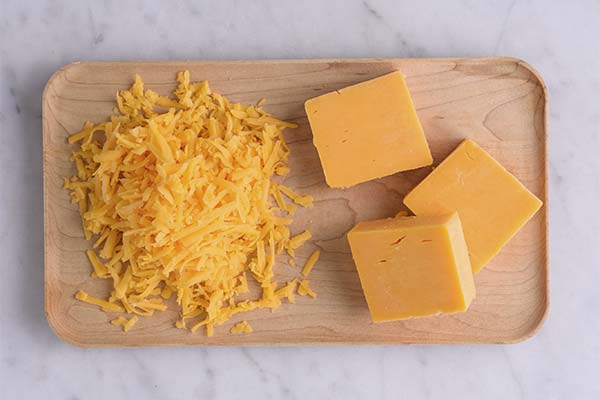
Beneficial effects of cheddar cheese:
- Mineralizes bones, tooth enamel, prevents childhood rickets, osteoporosis, chipped teeth.
- Supports muscle contractions, reproductive function, mucosal, skin, gastrointestinal health.
- Increases color perception, crepuscular adaptation, visual acuity.
- Participates in hematopoiesis, energy metabolism, redox reactions.
- Reduces the risk of heart disease.
- Normalizes sleep.
- Increases stamina, efficiency.
- Stimulates the production of hydrochloric acid, improves digestion.
- Prevents anemia, leukopenia, anorexia.
Selenium in cheese is an antioxidant and immunomodulator that improves thyroid function, the brain. It protects cells from damage, reduces the risk of vascular disease, myocardium.
Harm and contraindications.
Cheese containing milk protein, 50% of fatty acids in the amount of dry matter and a lot of salt is contraindicated in lactose intolerance, allergies, obesity, acute pancreatitis, gastritis, colitis.
No more than two slices of cheddar can be eaten by people with hypertension, impaired kidney function, a tendency to edema.
How to choose and store
Real British cheese is covered with a waxy or buttery crust, in the structure has no voids. The taste of the fermented product is always sour and nutty. The original product comes in the form of a cylinder or round head.
Pay attention to the composition. It should contain no other ingredients except milk, calcium chloride, sourdough, salt. If the label indicates fats other than dairy, discard the product, as it has nothing to do with cheddar.
Optimal storage conditions for hard cheeses - temperature 3-10°C, humidity 90%. At home the useful and gastronomic properties of the sour milk product are preserved in the refrigerator for 2-4 weeks. Cheddar is placed in a glass container with a tightly closing lid or wrapped in foil or parchment. In the latter case, the packaging has to be changed every two days to prevent the formation of mold.
Extends the period of preservation of consumer properties of a piece of sugar, put beside the cheese.
Three months of usable cheddar sent to the freezer.
Where to buy and how much it costs
Cheddar is sold in grocery stores, cheese shops and online marketplaces for 800-3000 p, depending on the age of maturation.
How and with what you eat cheddar
To restore the consistency and organoleptic properties, take the cheese out of the fridge an hour before eating. Cheddar is eaten sliced as an appetizer to wine, beer, or added to salads, baked goods, first and second courses.
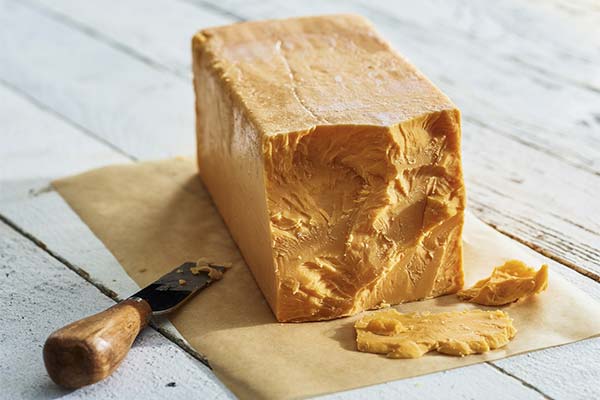
In the UK, the product is eaten with banana, mustard, pear, celery.
What does it go with?
Fish, vegetables, pasta, bananas, grapes, peaches, dates, almonds, cashews, walnuts, fresh greens, bitter beers, go with cheese with a spicy sour flavor.
The English have a popular snack of cheese sauce spread on bread. This dish has the original name of "Welsh Hare".
What wine goes with cheese?
Red wines with a bright bouquet, such as Chianti, Cabernet, Shiraz, Merlot, are served with aged cheddar.
Vintage port, sherry, aged white sparkling wine, pungent reds such as Bordeaux, Sangiovese, and Rioja pair with hard cheese.
How to make cheddar cheese at home
To make cheddar according to the classic recipe you will need:
- 5 L of milk;
- mesophilic sourdough starter:
- rennet;
- 40 mg salt;
- 1 g calcium chloride.
How to prepare:
- Heat the milk on the stove to 32°C. Add the calcium chloride dissolved in water, the cheese starter, which can be replaced by 100 ml of sour cream or buttermilk.
- After 30 minutes add the rennet and leave for an hour.
- Cut the resulting clot into cubes with sides of 5 cm.
- After 10 minutes put the cheese mass in a water bath. When it is heated to 40°C, knead for up to half an hour. The squares should shrink in size and stick together.
- Remove the pan to a warm place so that the cheese grains settle to the bottom.
- After half an hour, drain the whey, and place the container with the clot in another larger saucepan with water heated to 42 degrees. Keep in it for 10 minutes, so that the clot becomes spongy.
- Divide the cheese dough into 2 pieces, put them on top of each other in a pan set at an angle to drain the whey. Every 10 minutes, turn the pieces on different sides.
- After the cheddar process, remove the elastic cheese dough from the container, cut into cubes with 1.5-3 cm sides, and return to the water bath.
- Salt and mix thoroughly.
- Cover the form with gauze, put the cheese on it, cover the ends of the cloth, set the 10-kilogram press for half an hour.
- Change the gauze, invert the cheddar, and increase the weight of the press to 20 pounds. After an hour, place a 30-kg gauze and press for 20 hours.
- Straighten the head by trimming off the ranchers. Leave to dry out at room temperature for two days, turning occasionally.
- Place the cheese in a vacuum bag, make a cloth bandage or fill with wax.
The minimum shelf life of a fermented dairy product is 3 months.
What you can make with cheddar: recipes
Hard cheese grated on a fine grater or cut into thin slices is added to soups, sauces, omelets, pasta, and salads. Cheddar is used to make cheese biscuits, sandwiches, lasagna, pizza, and fondue.
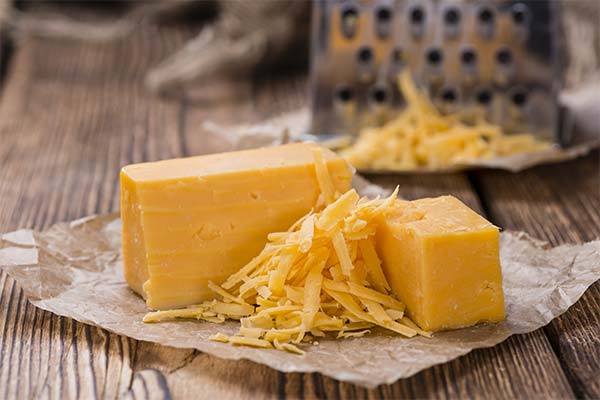
Pizza
To bake a delicious pizza according to the Italian recipe, prepare the products:
- 1.5 tbsp. wheat flour;
- 1 tbsp. white yogurt;
- 150 grams of cheese;
- 100 g ham;
- 200 г onions;
- 2 cloves garlic;
- 100 g tomato sauce;
- 5 g basiloregano;
- salt, pepper;
- olive oil.
Preparation Steps:
- Combine yogurt, salt, and a spoonful of flour. Whisk with a mixer.
- Knead the dough by hand, gradually adding the remaining flour.
- Roll out the dough flat on a baking sheet covered with parchment.
- Saute the onion with the salt and pepper in the oil until golden. Add garlic, lightly minced and cook a minute more.
- Brush the dough with tomato sauce. Place the contents of the pan as a second layer. Place slices of ham on top of the onion and garlic. Sprinkle with grated cheddar, add oregano.
- Bake the pizza for 12-15 minutes in an oven preheated to 220 degrees.
Serve in portions, sprinkled with basil.
Salad .
When serving in portions, small vases on a low stem will do for a half layered salad.
Ingredients:
- 300 g smoked chicken;
- 3 hard-boiled eggs;
- 80 g cheddar;
- 150 г fresh cucumbers;
- 250 г boiled potatoes;
- 1 carrots;
- salt, pepper;
- 60 г mayonnaise.
How to make:
- Dice the cucumbers, eggs, potatoes, chicken.
- On a grater grate the cheese, carrots.
- Combine eggs, potatoes, chicken, mayonnaise, salt, pepper, mix. Spread in bowls.
- Top with layers of cucumber, carrots, cheddar.
Allow the salad to stand in the fridge for at least 2 hours before serving.
Pasta
To make American-style macaroni and cheese, you will need:
- 300 g of pasta;
- a glass of milk;
- 100 g of flour;
- 150 г mozzarella;
- 300 g cheddar;
- salt;
- 50 г butter.
How to Prepare:
- Grate both types of cheese on a coarse grater.
- Put a pot of water on the stove. Once it boils, salt it and throw in the pasta. Cook for 8-10 minutes.
- Prepare the cheese sauce.
- Melt the butter in a saucepan, add the flour. Heat for a couple of minutes, stirring constantly.
- Pour in the milk and simmer until the sauce thickens.
- Add the cheddar and mozzarella. Once the cheese is melted, remove the saucepan from the stove.
- Rinse cooked pasta in a colander and transfer to the sauce.
This dish is very filling and calorie-dense. For those who like a delicious cheese crust, you can bake the pasta with the sauce in the oven.
Cheese sauce
You will need a minimum of time and products to make the sauce:
- 250 g cheddar;
- 100 ml of milk;
- 100g butter;
- 2 tbsp. flour.
How to make it:
- Melt butter in a frying pan or microwave.
- Pour the flour into the warm milk.
- Combine the ingredients in a saucepan. Bring to a boil.
- When the mixture thickens, add the cheese grated on a fine grater. Stir until smooth.
Eat the sauce with boiled pasta, chips, meat, baked vegetables.
Cheese Soup
Nutmeg and wine give this dish a savory flavor.
Product set:
- 0.5 l of chicken broth;
- 80 gr. cheese;
- 2 yolks;
- 20g butter;
- 80 ml of white dry wine;
- A pinch of nutmeg;
- 2 tbsp. sour cream;
- 20 grams of flour;
- pepper, salt.
Method of preparation:
- In a heavy-bottomed saucepan, melt the butter and fry the flour.
- Add broth. Stir thoroughly until no flour lumps are formed.
- Season with salt and pepper and season with nutmeg.
- Combine sour cream and egg yolks in a bowl and stir to combine.
- Pour wine into broth, bring to boil, reduce heat to minimum.
- In a saucepan, heat the wine for a minute and then remove from the heat.
- Add the grated cheddar. Stir to melt the cheese more quickly.
Serve the dish hot with white bread or croutons, greens, sour cream.
What you can substitute in recipes
In salads, pastas, baked goods and other dishes, cheddar is replaced by other hard cheeses with a bright flavor, aroma. Edam, Gouda, Maasdam, Roquefort, Colby, Cheshire, Dutch cheddar cheese will not fully replace cheddar, but will work as an alternative.
Interesting Facts
Informative and surprising facts about cheese:
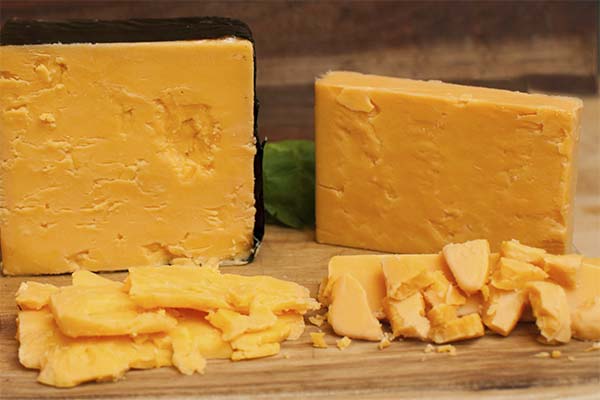
- At the 1964 New York World's Fair, 15,800 tons of cheddar was presented. It took the single milk yield of 16 thousand cows to produce it.
- In 2009, Great Britain launched the product into space. The cheese returned safely to Earth.
- Scientists from Texas proved that aged cheddar and its analogues can increase life expectancy by a quarter.
- To please fans of the lactic acid product, cheddar was the first to be tinted with natural dyes.
- The Wookey Hole caves in Somerset, where the first original cheese matured, have become an entertainment site with attractions.
The recipe for English cheese with a rich history has been preserved to this day. Everyone can enjoy the bright rich taste of the product, get a complex of nutrients needed by the body.
«Important: All information on the site is provided solely for introductory purposes. Before applying any recommendations, consult with a health care professional. specialist before applying any recommendations. Neither the editors nor the authors shall be liable for any possible harm caused by materials."

